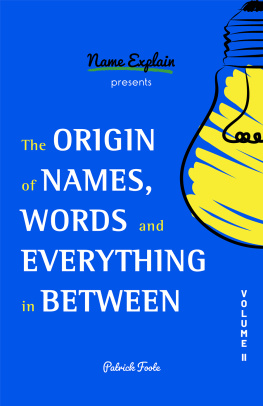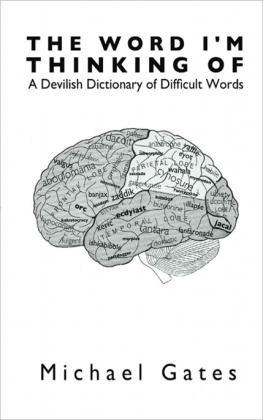


Copyright 2020 by Rockridge Press, Emeryville, California
No part of this publication may be reproduced, stored in a retrieval system, or transmitted in any form or by any means, electronic, mechanical, photocopying, recording, scanning, or otherwise, except as permitted under Sections 107 or 108 of the 1976 United States Copyright Act, without the prior written permission of the Publisher. Requests to the Publisher for permission should be addressed to the Permissions Department, Rockridge Press, 6005 Shellmound Street, Suite 175, Emeryville, CA 94608.
Limit of Liability/Disclaimer of Warranty: The Publisher and the author make no representations or warranties with respect to the accuracy or completeness of the contents of this work and specifically disclaim all warranties, including without limitation warranties of fitness for a particular purpose. No warranty may be created or extended by sales or promotional materials. The advice and strategies contained herein may not be suitable for every situation. This work is sold with the understanding that the Publisher is not engaged in rendering medical, legal, or other professional advice or services. If professional assistance is required, the services of a competent professional person should be sought. Neither the Publisher nor the author shall be liable for damages arising herefrom. The fact that an individual, organization, or website is referred to in this work as a citation and/or potential source of further information does not mean that the author or the Publisher endorses the information the individual, organization, or website may provide or recommendations they/it may make. Further, readers should be aware that websites listed in this work may have changed or disappeared between when this work was written and when it is read.
For general information on our other products and services or to obtain technical support, please contact our Customer Care Department within the United States at (866) 744-2665, or outside the United States at (510) 253-0500.
Rockridge Press publishes its books in a variety of electronic and print formats. Some content that appears in print may not be available in electronic books, and vice versa.
TRADEMARKS: Rockridge Press and the Rockridge Press logo are trademarks or registered trademarks of Callisto Media Inc. and/or its affiliates, in the United States and other countries, and may not be used without written permission. All other trademarks are the property of their respective owners. Rockridge Press is not associated with any product or vendor mentioned in this book.
Interior and Designer: Emma Hall
Art Producer: Sue Bischofberger
Editor: Erin Nelson
Production Editor: Andrew Yackira
Illustration 2019 Marco Marella
ISBN: Print 978-1-64611-259-3 | eBook 978-1-64611-260-9
R0
TO NANETTE, WHO TAUGHT ME THAT LANGUAGE IS A JOURNEY, THAT ITS IMPOSSIBLE TO BE BORED WITH A GOOD IMAGINATION, AND THAT THE HEART SEES BETTER THAN THE EYES.
Contents
Once upon a time, a word was born.
Our story begins more than 1.7 million years ago with the early members of our species, Homo sapiens. They had only recently started making stone tools when they first began giving names to the things they saw, heard, and did.
From here, humans learned to speak, share stories, and pass those stories down. We then came up with symbols to record events, to keep track of all we were learning and doing. The invention of language opened up a new universe of creative expression and imagination. It allowed us to create books, music, and art, to discuss philosophy and make new scientific discoveries.
Although there are some animals, like dolphins and elephants, that appear to have a form of language, human language remains the most advanced in the known universe.
Learning about the way our ancestors language grew and changed from simple communication to a world full of different ideas can help us better understand ourselves and each other.
In this book, well trace words back to their earliest forms, find out where they came from, and explore what turned them into the terms and phrases we use today. Through etymology, youll discover the stories behind our language, but first well answer two important questions.
And what does it have to do with learning new words?
Etymology is the study of the way words have changed over time. It looks at where words came from and when they were invented. By understanding word origins, we learn more about how and why the words were first made up. Origins can also tell us more about the places where those words were spoken. Through etymology, we can build our vocabulary and even guess what a word means based on its root. Most importantly, we will learn more about people and cultures from around the world.
Etymologists, or people who study word origins, trace words through history to learn how they came to be. You can think of them as word detectives. They learn about these word histories by reading historical records and documents and comparing the way words have changed over time. Sometimes it can be difficult to figure out exactly what a words origin or original meaning was, so etymologists make guesses based on the best evidence they can find.
Want in on a little secret? With this book, you can be a word detective too.


WORD JUNGLE
Languages have a history of borrowing from one another. English has diverse origins, with words from dozens of different languages, but most words in English come from four languages: Greek, Latin, Old French, and Old English.
These languages (plus many others spoken in Europe, Asia, and the Americas) are called Indo-European languages. This means they all come from a very ancient single language called Proto-Indo-European. We dont know as much about proto languages because there are no written records of them.
However, people who study languages have been able to piece together ideas of what these very early, unwritten languages may have looked like based on the similarities between the languages we speak today. Heres a closer look at how older languages have branched into the modern ones spoken around the world now.
ANCIENT GREEK AND LATIN
Nearly half of all words in the English language have Latin origins. Latin was the language spoken in the ancient Roman Empire. The Roman Empire was very powerful and claimed lands throughout Europe, North Africa, and Western Asia.
When the Romans claimed these lands, their language and culture were often adopted by the people who already lived there. Italian, French, Romanian, Spanish, and Portuguese are all very closely related to the Roman language and are therefore called Romance languages. Would you believe that it goes back even further?
The Romans got many of their words from Ancient Greek. Ancient Greek culture played an important role in developing our modern-day sports, science, medicine, philosophy, and politics. The Roman Empire built upon these ideas and spread them throughout Europe. We can thank the ancient Greeks for many of the science and philosophy words we learn about in school today.
Next page















